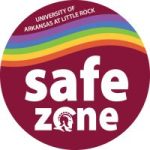Definitions
(from the Americans with Disabilities National Network):
Service Animal
A service animal (as defined by the ADA) means any dog that is individually trained to do work or perform tasks for the benefit of an individual with a disability, including a physical, sensory, psychiatric, intellectual, or other mental disability. Tasks performed can include, among other things, pulling a wheelchair, retrieving dropped items, alerting a person to a sound, reminding a person to take medication, or pressing an elevator button. Service animals are permitted anywhere at UA Little Rock that the student goes (with a few safety exceptions).
Examples of animals that fit the ADA’s definition of service animal, who have been specifically trained to perform a task for the disabled person:
- Guide Dog or Seeing Eye® Dog is a carefully trained dog that serves as a travel tool for persons who have severe visual impairments or are blind.
- Hearing or Signal Dog is a dog that has been trained to alert a person who has a significant hearing loss or is deaf when a sound occurs, such as a knock on the door.
- Psychiatric Service Dog is a dog that has been trained to perform tasks that assist individuals with disabilities to detect the onset of psychiatric episodes and lessen their effects. Tasks performed by psychiatric service animals may include reminding the handler to take medicine, providing safety checks or room searches, or turning on lights for persons with Post Traumatic Stress Disorder, interrupting self-mutilation by persons with dissociative identity disorders, and keeping disoriented individuals from danger.
- SSigDOG (sensory signal dogs or social signal dog) is a dog trained to assist a person with autism. The dog alerts the handler to distracting repetitive movements common among those with autism, allowing the person to stop the movement (e.g., hand flapping).
- Seizure Response Dog is a dog trained to assist a person with a seizure disorder. How the dog serves the person depends on the person’s needs. The dog may stand guard over the person during a seizure or the dog may go for help. A few dogs have learned to predict a seizure and warn the person in advance to sit down or move to a safe place.
Under Title II and III of the ADA, service animals are limited to dogs. However, entities must make reasonable modifications in policies to allow individuals with disabilities to use miniature horses if they have been individually trained to do work or perform tasks for individuals with disabilities.
Emotional Support Animal (ESA)
While Emotional Support Animals (sometimes called Comfort Animals or Therapy Animals) are often used as part of a medical treatment plan as therapy animals, they are not considered service animals under the ADA and are not allowed on the UA Little Rock campus. These ESAs provide companionship, relieve loneliness, and sometimes help with depression, anxiety, and certain phobias, but do not have special training to perform tasks that assist people with disabilities. Even though some states have laws defining ESAs, these animals are not limited to working with people with disabilities and therefore are not covered by federal laws protecting the use of service animals. ESAs provide people with therapeutic contact, usually in a clinical setting, to improve their physical, social, emotional, and/or cognitive functioning.
ESAs are not service animals under the ADA. Other species of animals, whether wild or domestic, trained or untrained, are not considered service animals either. The work or tasks performed by a service animal must be directly related to the individual’s disability. It does not matter if a student has a note from a doctor that states that the person has a disability and needs to have the animal for emotional support. A doctor’s letter does not turn an ESA into a service animal.
ESAs that do not qualify as service animals under the ADA may nevertheless qualify as reasonable accommodations under the Fair Housing Act. Students who would like to request an ESA in the university residence hall must fill out the ESA request form on the Housing site.
Student’s Responsibilities for Service Animals
- The service animal must be vaccinated and licensed as required by state law and/or local ordinance
- Service animal must be restrained on a leash at all times, unless for specific circumstances, at which time must be responsive to voice commands
- The service animal should be under the full control of the student, and always in close proximity to the student
- To the extent possible, the service animal should be unobtrusive to other students and the learning environment; uncontrolled barking, jumping on other people, or running away from the handler are examples of unacceptable behavior for a service animal
- Student must manage the animal’s need to urinate and defecate by taking the animal to an appropriate area; feces must be cleaned immediately and disposed of properly (not the responsibility of UA Little Rock)
Failure to meet these responsibilities may result in the handler and animal being asked to leave class. Handler must meet with staff in the Disability Resource Center before returning to class.
